Everything you need to know about the mitzvah of separating a piece of challah dough.
“והיה באכלכם מלחם הארץ תרימו תרומה לה,”
“ראשית ערסתכם חלה תרימו תרומה…”
The first portion (Reishis) of your kneading, you shall separate as a dough offering (challah)… In all your generations, give the first of your kneading as an elevated gift to G‑d (Bamidbar 15:20-21)
The word reishit indicates that which is the first, the finest, and the purpose of all that follows it. The removal and sanctification of the first and best of our dough illustrates a great truth of existence. That is, that all we do in this world, however mundane and ordinary it may seem, should begin with an acknowledgment of the Creator and a Higher Existence.
We begin every endeavor with the proclamation that “l’Hashem ha’aretz um’loah/The earth is G-d’s and all that fills it” (Tehillim 24:1).
The first and best of all that we accomplish is dedicated to a higher purpose.
We awaken in the morning and, with our first breath, sing praise to our Creator for the new day. Those less fortunate are fed before we take our own portion. We do not wait until we have finished with the “necessities” of life to get around to the “holiness.”
“Reishit arisoseichem” is “challah, l’Hashem.” The first and best of our sustenance is designated as challah for Hashem/G-d, and, as such, is dedicated to a higher purpose.
This is our truest reason for existence: to elevate and transcend through the work of our hands. Through making challah and separating the dough, we are perpetually bringing this awareness into our homes and into our lives.
May we merit to live a life in which we vividly observe the Divine unifying light in all of creation.
- From the words of the Lubavitcher Rebbe, in his address to women, 17 Sivan, 5740
The Background of “Challah”
- The word challah, although used to connote the bread we eat on Shabbos and Yomim tovim, is really the word for the piece of dough that is separated and given to the kohen, or, in our day and age, burned to be rendered inedible. So, the piece of dough that is separated is the origin of the word challah.
- Challah is also mentioned in the Torah as ‘loaves or cakes of bread’ indicating something which is shaped. (Vayikra 2:4, 7:12-13, 8:26, Bamidbar 6:15)
- When something is separated from the rest, and made sanctified, it is sometimes also called challah. For example, Adam is called “challato shel olam”/The challah of the earth ((Bereishis Rabbah 14:1).
- The word Challah can be seen as an acronym for Chelek L’olam Haba, a portion in the world to come. So whereas ‘bread/lechem’ represents the harshness of existence -as in “b’ziyas apecha tochal lechem” (3:19), Challah represents the healing of that curse with the promise of Olam Haba.
Source of the Mitzvah of Hafrashas Challah
- Challah, the separation of a portion of dough to be gifted to the kohen, is among the mitzvos that are categorized as “t’luyot ba’aretz” (directly connected with the physical of Israel).
- The Torah states: “Vehaya b’achalchem milechem ha’aretz… Reishis arisoseichem challah tarimu terumah…” And it will be when you eat from the bread of the land… the first of your dough shall be “challah,” separated, and given as a gift (Bamidbar 15:19,20). The challah gift is among the twenty-four gifts that we were directed to give to the kohanim, who served in the Beis Hamikdash.
- Some other mitzvos that are t’luyos ba’aretz include bikkurim, terumah, and ma’aser.
These other mitzvos were not applicable until 14 years after the B’nei Yisrael entered the land (seven years to conquer it and seven years to divide it amongst the shevatim). However the mitzvah to take challah applied from the moment that the Yidden crossed the Yarden into Eretz Yisrael.
- By Torah law, challah is taken only within the boundaries of Eretz Yisrael when all or a majority of Jews were living in Eretz Yisrael. However, the chachamim instituted the taking of challah outside the Land of Israel so that people living in the diaspora would not forget the mitzvah. Taking challah today, both inside and outside of the Land of Israel, is a rabbinic rather than a biblical mitzvah.
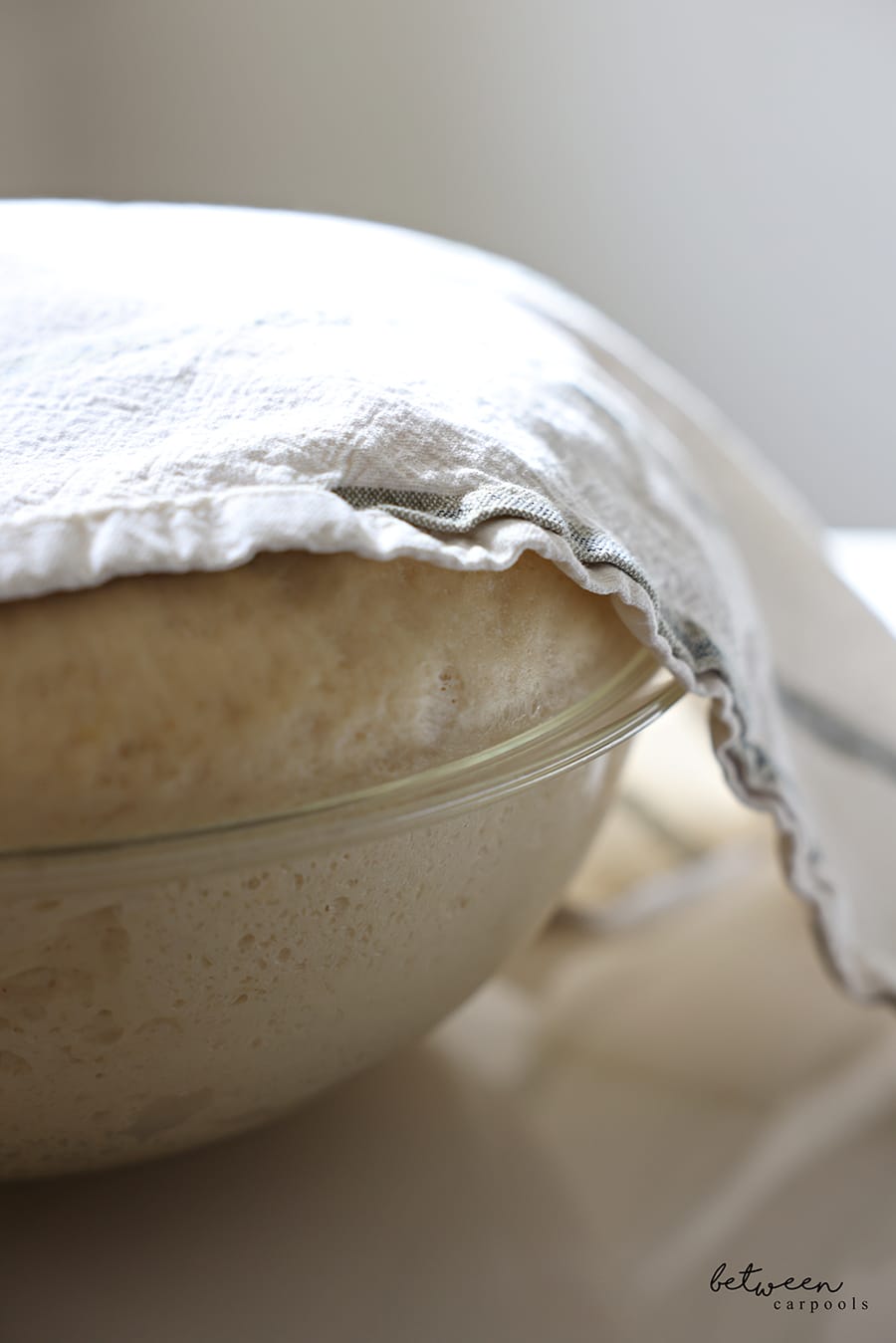
The Laws of Hafrashas Challah:
A Digest
(For a complete overview of the laws of Hafrashas Challah please see Kitzur Shulchan Aruch, Chapter 35.)
What Grains Require Challah Separation?
- Challah can be taken with any of the five grains enumerated in the Torah as “bread grains.” These include wheat, barley, oat, spelt, and rye. If challah is made with grains other than these five (such as a gluten-free challah that makes use of chickpea flour or other types of flours), it is not actual “challah,” i.e., the blessing of hamotzi lechem min haaretz is not recited upon eating it and there is no requirement to separate a piece of the dough with a blessing.
- If one desires to use multiple flours, and some are not from the “5 bread grains” then as long as the majority of the flour is from the 5 grains, challah can still be separated and the blessing of hamotzi is still said. For example; Adding gluten-free all purpose flour mix to gluten-free oat flour when making gluten-free challah is halachically permissible as long as the oats account for a majority of the flour.
Which Doughs Need Hafrasha?
Which liquids make it challah?
To separate challah with a blessing, the majority of the liquid content must be water.
If the majority of the liquid is not water (ie; honey, oil, eggs, milk, juice etc.) challah is to be separated without a blessing so long as there is at least one drop of water in the dough.
When making a loose or pourable dough (such as a cake batter) or if making sweet pastries, challah does not usually need to be taken. However, if baking in very large quantities (with approx. 5 lbs or more of flour) one should consult with a halachic authority.
Flour requirement for Separation of challah:
- Less than 2 lb 11 oz (or 1230 grams) of flour: no separation of challah is required
- Between 2 lb 11 oz and 3lb 11 oz (1230-1666.6 grams) of flour: challah is to be separated without a bracha
- Over 3 lb 11 oz. Challah is separated with a bracha. Some hold that you separate with a bracha for as little as 3 lbs and others hold that you need 5 lbs. Ask your own LOR as there are differing opinions.
Combining Doughs:
Multiple doughs that are each too small to separate on their own:
- If you are simultaneously making multiple doughs that are each too small to require challah separation (such as if your mixer is too small to contain a large batch of dough and you are therefore making multiples of the same recipe), the doughs may be combined once kneaded to allow for the separation of challah.
- Simply place all the small doughs into one container and cover the container with a cloth. Separate the challah from one of the dough pieces and make the blessing as usual.
- If however, you are making many small doughs at once but they will each be baked in another person’s oven (such as if a group of friends gather to bake challah together but each participant makes a small batch of dough and will take it home to bake), the doughs cannot be combined to separate challah with a blessing.
- Similarly, if a person bakes several small batches of bread or cake and then puts them all together in a bag, container or freezer, he or she must separate challah if the combined batches meet the hafrashas challah requirements. For example, if a person bakes cookies in three separate batches, with each batch containing 2 pounds of flour, and she then combines all of the cookies into one container, such as a cookie jar, she must separate a piece of “challah” from the cookies.
- Multiple doughs that are each large enough for challah separation:
- When separating challah for several batches of dough at one time (when each one meets the hafrashas challah requirements), all of the dough should be in close proximity to each other at the time of the declaration. If the dough is not in a bowl or container, it is sufficient for all of the dough to be in the same room as the person who is separating the challah. However, if the batches of dough are in bowls or containers, it is important that the bowls be open and touching while separating the challah.
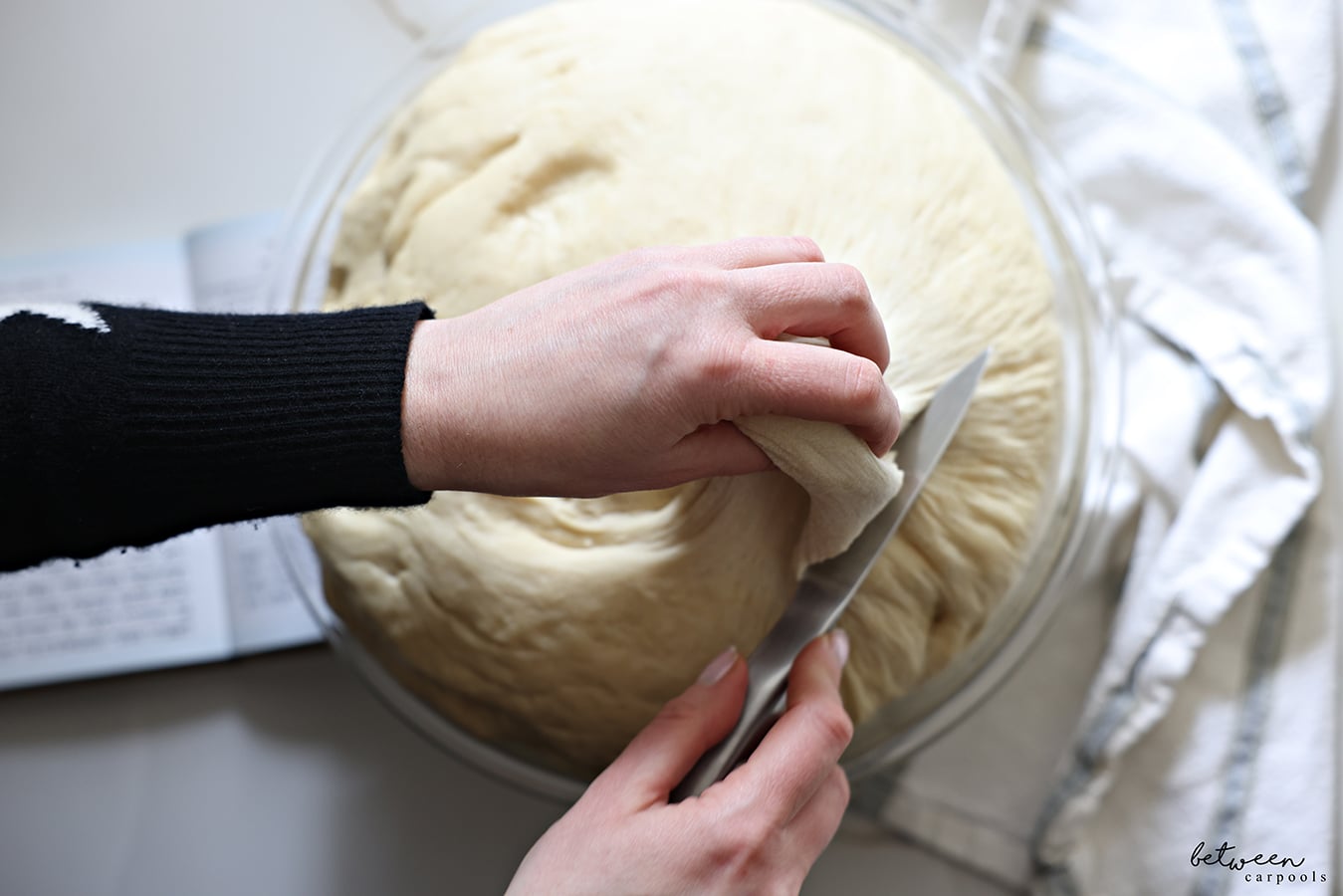
Who May Separate Challah?
- The mitzvah of challah separation applies to any Jew over the age of bar or bas mitzvah who makes a dough that meets the requirements for separation (see above). However this mitzvah has become known as one that is specifically woman-centric and one of the three mitzvos unique to women. As part of her preparation of food for her family, the mitzvah of challah becomes symbolic of the practice of keeping kosher, a mitzvah in which the woman of the house plays the main role. If there is no woman available to separate the challah, a man may perform this mitzvah. If, however, a man and woman are both available, this mitzvah should be performed by the woman.
What Do We Do with the Separated Piece of Challah:
- The piece of challah that was separated should be burned until it is rendered inedible.
- It can be burned on an open flame or in an oven. If it is being burned in an oven, please note that the challah should not be burned while anything else is being baked in that oven at the same time. If however, it is well-wrapped in aluminum foil, or the like, it may then be burned in the oven together with other food that is baking.
- Once the piece of challah has been burnt, it should be discarded but does not need to be disposed of in any particular manner.
- If it is not possible to burn the piece of dough, there are some opinions that say that it is also acceptable to discard it in the garbage. Care should, however, be taken to ensure that the piece of dough is properly wrapped—preferably double-wrapped—so that it doesn’t come in contact with anything else in the trash. This however is not the preferred method.
- Burning is always considered the best option.
- Some have the custom to freeze and burn with chametz erev Pesach.
Oops. Forgot to Take Challah:
- If a person forgot to separate challah before baking the dough, or the dough was too runny to separate while it was raw (such as in a gluten-free oat challah batter), or a person baked cakes that require challah separation, challah may (and should) be separated after baking. Combine all the baked challahs or cakes together in a container and cover them with a cloth. Remove a small piece from one of the loaves and make the bracha as usual.
- If a person forgot to separate challah before Shabbos and only realized once Shabbos began, the challah may still be eaten on Shabbos, provided that this took place outside of Eretz Yisrael. A slice of the challah loaf from which challah can be separated after Shabbos should be set aside. This slice should be large enough for the challah to be separated from it while still leaving over a portion of challah to be eaten thereafter.
Separating Challah from Dough that is Not Being Used for Bread:
- For large quantities of cakes, cookies, and desserts that meet the requirements for challah separation, the laws of separating challah apply. However, since the water content in baked goods is generally the minority of the liquid, challah should be separated without a blessing.
- When the dough is intended for cooking or frying (rather than baking), such as doughnuts or dumplings, challah should be separated without a bracha. However if even a small portion of the larger dough will be baked, a bracha may be made over the separation.
- If the intention is to bake dough, then even if it will be partially baked for a cake, the dough still requires Challah to be separated, with a Bracha. Even for those who do not hold that Challah is separated when making cake (i.e. babka) If you are using your 5 lb batch of challah and making a babka with 1/6th of the dough, you will still have enough dough to separate with a bracha according to most opinions. (source: “Shulchan Aruch” Y.D.
329:1-2, “Shach” 1 ad loc).
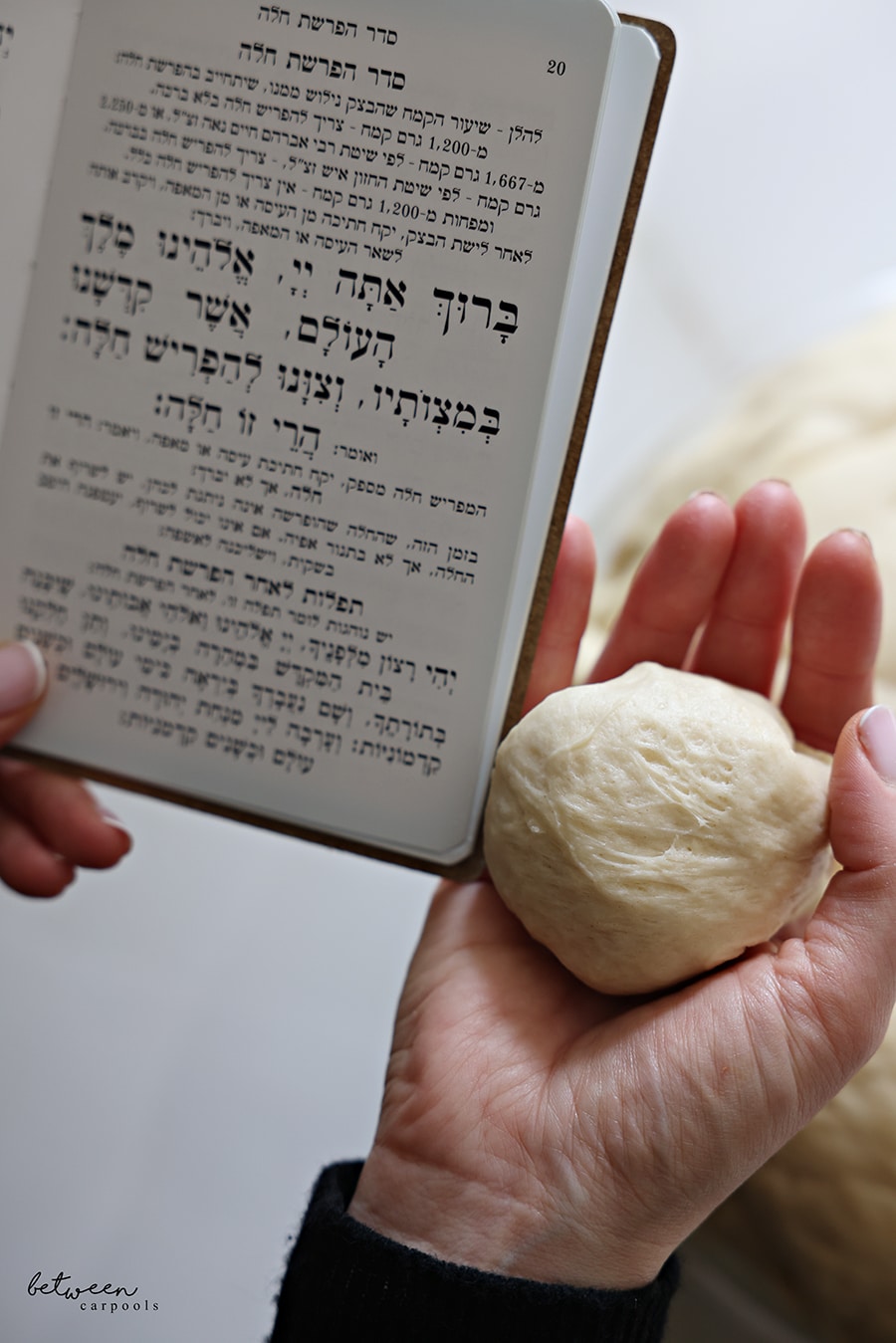
The Bracha
Recite this blessing with deep intention. This is your moment to reconnect.
Visualize your neshamah, infinite and eternal, reconnecting to its Source, the Infinite and Transcendent light of Hashem, wherein all is possible and all blessings and goodness already exist. Draw the brachos down from this space of Everything into your dough and into all of your life.
בָּרוּךְ אַתָּה ה’ אֱלהֵינוּ מֶלֶךְ הָעוֹלָם
אֲשֶׁר קִדְּשָׁנוּ בְּמִצְוֹתָיו וְצִוָּנוּ לְהַפְרִיש חַלָּה
(some add: תרומה, some add: מִן הָעִסָה)
Ba-ruch A-tah A-do-nai Elo-heinu Me-lech
ha-o-lam a-sher kid-sha-nu b’mitz-vo-tav
v’tzi-va-nu l’haf-rish challah
(some add: terumah, some add: min ha-i-sah)
You, Ado-nai, the Source of all blessings, our G-d, Master of the universe,
has made us holy with His mitzvot and instructed us to separate challah.
(some add: from the dough)
- Then, remove a small piece (approximately one ounce) from the dough.
- Immediately after separating it, hold the piece of dough aloft and say:
הֲרֵי זו ּ חַלָּה
Ha-rei zu challah
Behold, this is Challah
- Now, burn the dough or dispose of it appropriately.
Access a printable text of the bracha and the Yehi Ratzon that is customarily recited afterwards here in the Between Carpools Siddur.
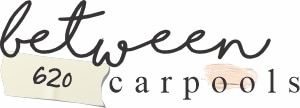

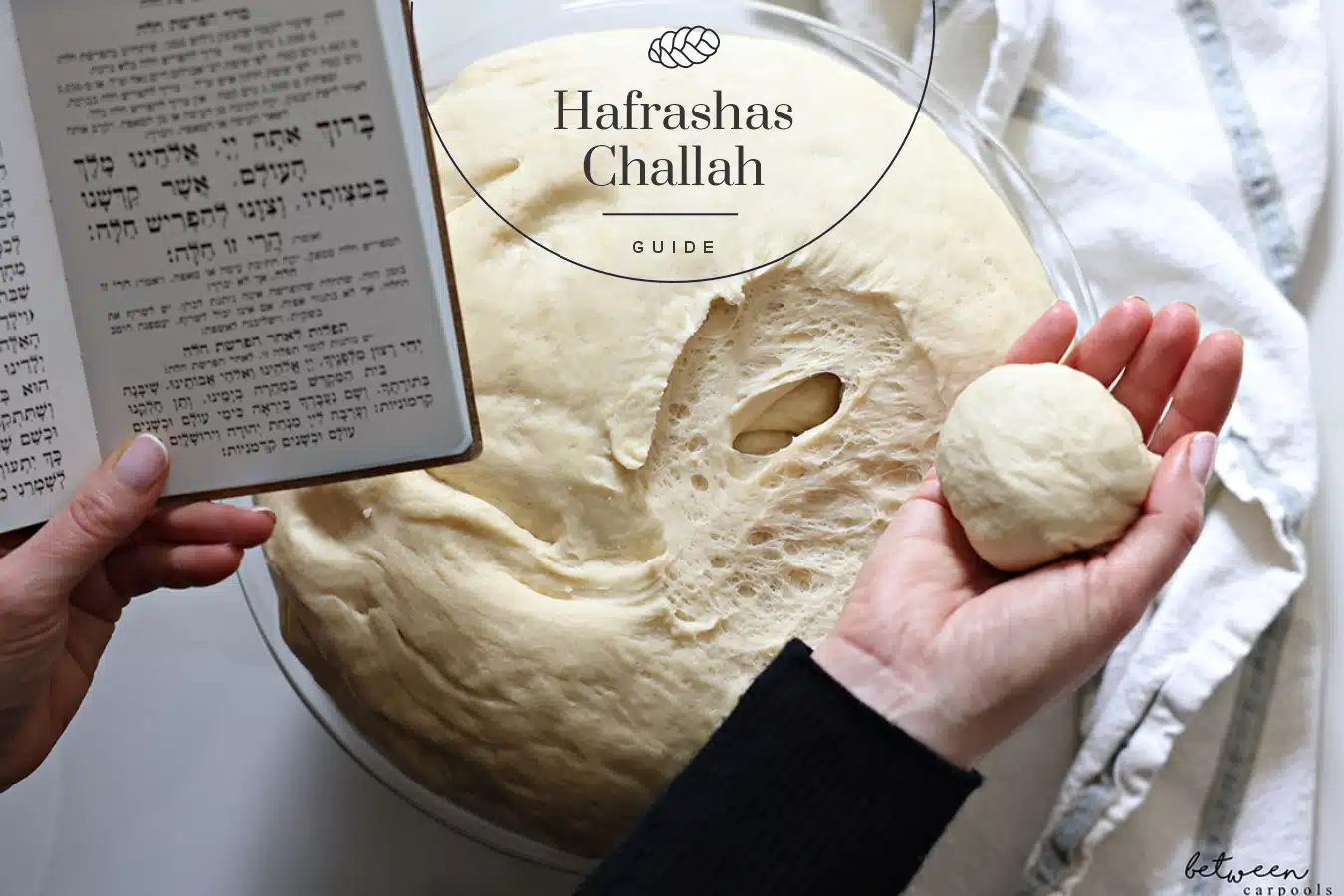

Can we please have the measurements of flour to take challa off in cups?
This is what I learned from my Rav:
16 cups- take challah with a bracha
9 cups- take challah without a bracha
less- no challah
One other thing to note that is not mentioned above – the challah that is taken off is considered treif.
One should be careful not to use a real utensil to poke it after or while it’s being burned as that could render the utensil treif.
But as a whole, amazing article! Very informative and I learned a few new things!
Has anyone found an effective way to burn the Challah without setting off the smoke alarm and making the house smell like smoke? My son loves to try to burn it outside in a foil pan, but we have not found a way to get the dough to actually catch fire, so it’s hard to get it to burn completely. Any ideas?
The amounts given in this article for taking challah with or without bracha are not necessarily the ones accepted by all poskim (many hold you need a lot more flour to take challah with a bracha). Ask your Rav to clarify the right amount according to his shita.
Agreed. I was told that it needs to be 4 lb 15 oz for a bracha. Please ask your own shaila.
Wow! Thank you so much!!!!!!!!
We dry out the dough on a napkin.
When it’s all dried out it goes into a bag
Then when we make a fire to burn it, it burns completely because there’s no more moisture.
I do the same. I leave it high up in my kitchen until the next week, when I make challah again and a new piece replaces it. The dried out dough goes into a bag in the freezer, to be burned before Pesach.
I was taugh5 that it should be burnt beefier eating the challah.
Interesting! I never thought to dry it out before freezing! I just freeze them and burn erev pesach.
Sucha nice informative article thanks!! Don’t forget also when making a few loaves of sourdough hafrasha needs to be taken.. I didn’t see it mentioned.
I beleive the halachos of where to burn the challah might be different in eretz yisroel and chutz la’aretz so please add in that people in Eretz Yisroel should ask their LOR before burning it in their oven
Wow! Amazing article!
In Passaic Rabbi West gave a shiur and said the best way is to put a bag inside out and then pull off a piece and after a bracha discard. He said burning can be more problematic – and to be careful not to pull directly with hand but with a bag. I see you wrote that burning is preferable. So there are other opinions.